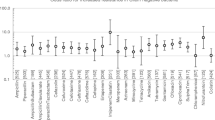Abstract
Objectives:
The objectives of this study were to determine (1) the increase in antimicrobial resistance to frequently used antibiotics in the hospital setting over time and (2) the correlation between the amount of use of an antibiotic in a specific medical specialty and the observed resistance to that antibiotic in that specialty.
Method:
The total use of antibiotics and the use of ciprofloxacin (CIP), co-amoxicillin + clavulanic acid (AMCL) and firstand second-generation cephalosporins (CEF), respectively, in individual medical specialties were measured between 2001 and 2006 by means of prevalence surveys (two per year). The antimicrobial susceptibility patterns among E. coli isolated from hospitalized patients between 2003 and 2006 were obtained from the Laboratory Information System. Trends over time and correlation between use and resistance were calculated.
Results:
6,639 patients were included in the prevalence surveys, of whom 3.0% (195) were treated with CIP, 9.7% (642) with AMCL, and 3.5% (232) with CEF. 4,790 E. coli isolates were obtained from hospitalized patients. Resistance to all antibiotics significantly increased over time, with the regression line showing that the strongest increase in resistance was for CIP (2.6% per year). There were large variations in antimicrobial use between various medical specialties. A significant correlation was found between the ward-specific prevalence of use and the percentage of resistance for CIP (R = 0.81, p < 0.001) and AMCL (R = 0.82, p = 0.003).
Conclusion:
At the level of individual medical specialties within one hospital, a higher prevalence of antimicrobial use among patients was associated with a significantly higher observed antimicrobial resistance. The use of CIP was associated with a stronger increase in resistance than the use of beta-lactams.
Similar content being viewed by others
References
Kunin CM: Resistance to antimicrobial drugs. Ann Intern Med 1993; 118: 557–561.
Neu H: The crisis in antibiotic resistance. Science 1992; 257: 1064–1073.
Lipsitch M, Samore MH: Antimicrobial use and antimicrobial resistance: a population perspective. Emerg Infect Dis 2002; 8: 347–354.
Austin DJ, Kristinsson KG, Anderson RM: The relationship between the volume of antimicrobial consumption in human communities and the frequency of resistance. Proc Natl Acad Sci USA 1999; 96: 1152–1156.
Bronzwaer SL, Cars O, Buchholz U, Mőlstad S, Goettsch W, Veldhuijzen IK, Kool JL, Sprenger MJ, Degener JE: European antimicrobial resistance surveillance system. A European study on the relationship between antimicrobial use and antimicrobial resistance. Emerg Infect Dis 2002; 8: 278–282.
Binkley S, Fishman NO, LaRosa LA, Marr AM, Nachamkin I, Wordell D, Bilker WB, Lautenbach E: Comparison of unit-specific and hospital-wide antibiograms: potential implications for selection of empirical antimicrobial therapy. Infect Control Hosp Epidemiol 2006; 27: 297–682.
Harbarth S, Harris A, Carmeli Y, Samore M: Parallel analysis of individual and aggregated data on antibiotic exposure and resistance in gram-negative bacilli. Clin Infect Dis 2001; 33: 1462–1468.
Willemsen I, Groenhuijzen A, Bogaers D, Stuurman A, van Keulen P, Kluytmans J: Appropriateness of antimicrobial therapy measured by repeated prevalence surveys. Antimicrob Agents Chemother 2007; 51: 864–867.
Clinical and Laboratory Standards Institution. Performance standards for antimicrobial susceptibility testing. Fifteenth information supplement (M100-S15). CLSI, Wayne, 2005.
Livermore DM, James D, Reacher M, Graham C, Nichols T, Stephens P, Johnson AP, George RC: Trends in fuoroquinolone (ciprofloxacin) resistance in Enterobacteriaceae from Bacteremias England, Wales 1990–1999. Emerg Infect Dis 2002; 8: 473–478.
Goettsch W, van Pelt W, Nagelkerke N, Hendrix MG, Buiting AG, Petit PL, Sabbe LJ, van Griethuysen AJ, de Neeling AJ: Increasing resistance to fluoroquinolones in Escherichia coli from urinary tract infections in The Netherlands. J Antimicrob Chemother 2000; 46: 223–228.
EARSS Annual Report 2006. European Antimicrobial Resistance Surveillance System.
Lautenbach E, Strom BL, Nachamkin I, Bilker WB, Marr AM, Larosa LA, Fishman NO: Longitudinal trends in fluoroquinolone resistance among Enterobacteriaceae isolates from inpatients and outpatients, 1989–2000: differences in the emergence and epidemiology of resistance across organisms. Clin Infect Dis 2004; 38: 655–662.
Neuhauser MM, Weinstein RA, Rydman R, Danziger LH, Karam G, Quinn JP: Antibiotic resistance among gram-negative bacilli in US intensive care units: implications for fluoroquinolone use. JAMA 2003; 289: 885–888.
Goossens H, Ghysels G, Van Laethem Y, De Wit S, Levy J, De Mol P, Clumeck N, Butzler JP, Wenzel RP: Predicting gentamicin resistance from annual usage in hospital. Lancet 1986; 2: 804–805.
Van Eldere J, Mera M, Miller LA, Poupard JA, Amrine-Madsen H: Risk factors for development of multiple-class resistance to Streptococcus pneumoniae strains in Belgium over a 10-year period: antimicrobial consumption, population density and geographic location. Antimicrob Agents Chemother 2007; 51: 2491–2497.
Garau J, Xercavins M, Rodríguez-Carballeira M, Gómez-Vera JR, Coll I, Vidal D, Llovet T, Ruíz-Bremón A: Emergence and dissemination of quinolone-resistant Escherichia coli in the community. Antimicrob Agents Chemother 1999; 43: 2736–2741.
Endtz HP, Ruijs GJ, van Klingeren B, Jansen WH, van der Reyden T, Mouton RP: Quinolone resistance in campylobacter isolated from man and poultry following the introduction of fluoroquinolones in veterinary medicine. J Antimicrob Chemother 1991; 27: 199–208.
Oteo J, Lazaro E, de Abajo FJ, Baquero F, Campos J, Spanish members of EARSS: Antimicrobial-resistant invasive Escherichia coli, Spain. Emerg Infect Dis 2005; 11: 546–553.
Enne VI, Livermore DM, Stephens P, Hall LM: Persistence of sulphonamide resistance in Escherichia coli in the UK despite national prescribing restriction. Lancet 2001; 357: 1325–1328.
Lautenbach E, Metlay JP, Bilker WB, Edelstein PH, Fishman NO: Association between fluoroquinolone resistance and mortality in Escherichia coli and Klebsiella pneumoniae infections: the role of inadequate empirical antimicrobial therapy. Clin Infect Dis 2005; 41: 923–929.
Karlowsky JA, Jones ME, Thornsberry C, Friedland IR, Sahm DF: Trends in antimicrobial susceptibilities among Enterobacteriaceae isolated from hospitalized patients in the United States from 1998 to 2001. Antimicrob Agents Chemother 2003; 47: 1672–1680.
Author information
Authors and Affiliations
Corresponding author
Rights and permissions
About this article
Cite this article
Willemsen, I., Bogaers-Hofman, D., Winters, M. et al. Correlation between antibiotic use and resistance in a hospital: Temporary and ward-specific observations. Infection 37, 432–437 (2009). https://doi.org/10.1007/s15010-009-8325-y
Received:
Accepted:
Published:
Issue Date:
DOI: https://doi.org/10.1007/s15010-009-8325-y




